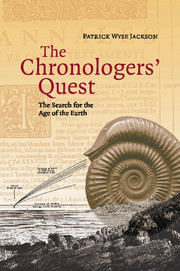Book contents
- Frontmatter
- Contents
- List of illustrations
- List of tables
- Preface
- Acknowledgements
- 1 The ancients: early chronologies
- 2 Biblical calculations
- 3 Models of Aristotelian infinity and sacred theories of the Earth
- 4 Falling stones, salty oceans, and evaporating waters: early empirical measurements of the age of the Earth
- 5 Thinking in layers: early ideas in stratigraphy
- 6 An infinite and cyclical Earth and religious orthodoxy
- 7 The cooling Earth
- 8 Stratigraphical laws, uniformitarianism and the development of the geological column
- 9 ‘Formed stones’ and their subsequent role in biostratigraphy and evolutionary theory
- 10 The hour-glass of accumulated or denuded sediments
- 11 Thermodynamics and the cooling Earth revisited
- 12 Oceanic salination reconsidered
- 13 Radioactivity: invisible geochronometers
- 14 The Universal problem and Duck Soup
- Bibliography
- Index
6 - An infinite and cyclical Earth and religious orthodoxy
Published online by Cambridge University Press: 02 December 2009
- Frontmatter
- Contents
- List of illustrations
- List of tables
- Preface
- Acknowledgements
- 1 The ancients: early chronologies
- 2 Biblical calculations
- 3 Models of Aristotelian infinity and sacred theories of the Earth
- 4 Falling stones, salty oceans, and evaporating waters: early empirical measurements of the age of the Earth
- 5 Thinking in layers: early ideas in stratigraphy
- 6 An infinite and cyclical Earth and religious orthodoxy
- 7 The cooling Earth
- 8 Stratigraphical laws, uniformitarianism and the development of the geological column
- 9 ‘Formed stones’ and their subsequent role in biostratigraphy and evolutionary theory
- 10 The hour-glass of accumulated or denuded sediments
- 11 Thermodynamics and the cooling Earth revisited
- 12 Oceanic salination reconsidered
- 13 Radioactivity: invisible geochronometers
- 14 The Universal problem and Duck Soup
- Bibliography
- Index
Summary
In the 1990s, when the Geological Gallery at the American Museum of Natural History in New York was being redesigned, a series of moulds was made of classic geological sites and these were cast in fibreglass and installed in the geology exhibition. While there one can gaze at a piece of Scotland: Siccar Point on the Berwickshire coast, to be precise, which is one of the sites in the world that historians of geology would wish to visit to pay homage to the early geological fathers. Recently I was in New York and made my way to the gallery. I have to confess that I have never visited the real Siccar Point. Nevertheless its impact on me was palpable – I had to sit down in the gallery, and I gazed at the structure, identifying the almost upright beds overlain unconformably by almost horizontal beds tilted at a low angle. I realised that perhaps I was experiencing a similar sensation to that of the great gentleman geologist James Hutton (1726–1797) when he first saw the actual site over two hundred years earlier.
THE GENESIS OF A NEW THEORY OF THE EARTH
Sitting in the parlour of his Edinburgh house at St John's Hill on the afternoon of 7 March 1785, the regal-looking gentleman would have been somewhat apprehensive. It was nearly teatime but I suspect he would not have wanted to eat much; he had more pressing matters on his mind.
- Type
- Chapter
- Information
- The Chronologers' QuestThe Search for the Age of the Earth, pp. 86 - 104Publisher: Cambridge University PressPrint publication year: 2006



